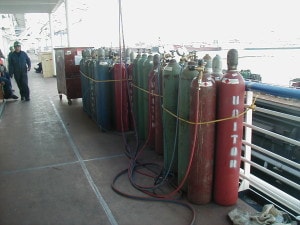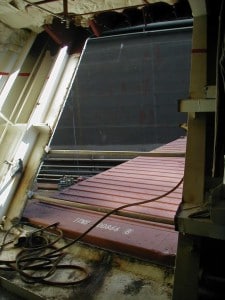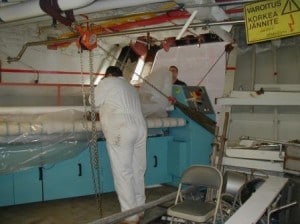The welding of the new section went faster than expected and by 2 am. The cranes were released and returned to regular work. To the great relief of one of the contractors (who is doing the fitting out of the interior of the new section). His team had run out of “gas” as they called it. Not gas as for a car but acetylene, oxygen and Co2. Without those gases you cannot weld and burn and as it all takes place about 100 feet above sea level, you also cannot carry the heavy bottles onto the ship from dry – dock. Thus the cranes were badly needed again.
Now with the main piece in place the dry dock can continue on routine and work towards the deadline of late evening 12 January as the ship will leave Freeport to start her cruise the next day. As we work with deadlines it means that everybody is always in a hurry. When people are in a hurry, they try short cuts and that might result in problems later on. Hence Holland America has developed some routines to minimize any problems, as far as possible, from occurring.
 s
s
One of the bottle banks we have on board for all the work. These are located in various area’s close to where work is being done but still at a safe distance away from the actual work location.
One of the major issues that we face in dry dock is loosing ceiling panels. Wiring has to be pulled, the under decks accessed for welding above and new pipes installed. Basically it seems that nobody can do any work without opening ceiling panels or overheads as they are mostly called. When these are taken out they are tossed aside and by the end of dry dock several (not to say many) will have disappeared or will have been severely damaged. It does not look very good of course if guests have to walk through corridors and be in cabins with half the ceilings missing. Hence the function of Ceiling Panel Controller (CPC) was developed.
If somebody needs a panel removed; a form/permit has to be obtained from the CPC and on that form has to be listed how many panels will be removed, location of the removal and WHERE these panels will be stored while they are out; so that they can be retrieved later. As not everybody is adhering to this policy there is one senior officer assigned to this function to inspect and “kick a…” if needed to make all comply. During the Veendam SOE of 2006 this function was carried out by a chief officer and he had to try to control over 1100 panels. When dry dock was finished there was only one missing. We are still convinced that that panel had already been taken out before dry – dock. This time it is done by the navigation officer as we only have one chief officer during this dry dock. We have to wait and see what the final result will be this time.
Another function and relating to safety is the Penetration Inspector. As the ship is divided in sections by steel bulkheads, to stop or slow down fire or water from spreading through the ship, it means that it is not so easy to run a cable or wire from one part of the vessel to the other. A hole, or penetration, has to be made to lead the cable through the fire or watertight bulkhead. This hole has to be filled then with a fire proof compound that hardens around the cable and fills the hole completely so that the fire integrity and or water tightness is restored. Not all sub contractors are that concerned about where to make a penetration and are sometimes even less concerned about properly filling the hole (with the correct putty) afterwards. Hence the function of the Penetration Inspector was created. He approves the location for the penetrations, then gives permission for the work and before an area is closed off, he inspects the completed work. Quite often Lloyds Register also wants to see the result and to have a function like this makes it a lot easier to deal with the sometimes hundreds of these little holes and certainly makes it much safer.
 The hole cut in the portside of the hull on deck 3 where the ships laundry is located. Containers have been positioned outside and they will act as a platform to get the old machines out and the new ones in.
The hole cut in the portside of the hull on deck 3 where the ships laundry is located. Containers have been positioned outside and they will act as a platform to get the old machines out and the new ones in.
One penetration that our inspector is not in charge of, is the enormous hole that has been cut in the side of the hull. The main laundry is getting a new folding and ironing machine and the only way to get the old one (20 feet wide and 30 feet long) out is in three parts and via a hole in the side of the ship. Today the left overs of the old machine went out and the new machine came in. When all is done the ship yard will weld the hull plate back again.
 It takes a big man to push a big machine through a big hole.
It takes a big man to push a big machine through a big hole.

January 10, 2010 at 10:50 am
Hello captain Albert,
With interest I read your blog about the dry-dock activities on the Prinsendam. My wife and I already sailed many times with this beautiful ship. Already in the periode when the name still was “Sun” en later on when it was the “Seaborn Sun” we enjoyed some unforgettable cruises with this really elegant ship. The last time we were on the Prinsendam was with you as captain last summer to the “Top of the world”.
Now the Prinsendam is changed and an extension is build on the stern of the ship I am afraid that the look and feel of the ship will change. We just finished a cruise with the already changed Rotterdam (holyday cruise Fort Lauderdale – San Diego). The Rotterdam is completely changed according HAL’s Signature of Excellence program. In my opinion a lot of these changes are not directly improvements. The looks of the ship changed dramatically. The stern of the ship looks not so elegant as before. Not to speak of the many technical problems the ship and crew had during this holyday cruise. I hope that the Prinsendam won’t have that many problems during the coming cruises
With kind regards,
Henry
January 12, 2010 at 3:55 pm
What an amazing process! I was just aboard for the Amazon Explorer and Holiday cruises (disembarked 1/4) and heard bits and pieces of what was to be done. Thank you for your excellent explanations of the tasks! Awesome organization and teamwork. Thanks for sharing your world with us!